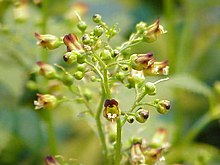Scrophularia
- "Figwort" redirects here. This is also used for some other plants; see below.
| Scrophularia | |
|---|---|

| |
| Scrophularia nodosa | |
| Scientific classification | |
| Kingdom: | |
| (unranked): | |
| (unranked): | |
| (unranked): | |
| Order: | |
| Family: | |
| Genus: | Scrophularia |
| Species | |
|
About 200, see text | |
The genus Scrophularia of the family Scrophulariaceae comprises about 200 species of herbaceous flowering plants commonly known as figworts. Species of Scrophularia all share square stems, opposite leaves and open two-lipped flowers forming clusters at the end of their stems. The genus is found throughout the Northern Hemisphere, but concentrated in Asia with only a few species in Europe and North America.
Scrophularia species are used as food plants by the larvae of some Lepidoptera species including Phymatopus hectoides.
Some species in this genus are known to contain potentially useful substances, such as iridoids, and several Scrophularia species have been used in various traditional medicines around the world, such as the Ningpo figwort or Chinese figwort (S. ningpoensis). The name Scrophularia comes from scrofula, a form of tuberculosis, because several species have been used to treat this disease.
As an herb used in Traditional Chinese Medicine, it has found use in a formula to treat arthritis. The herb has demonstrated a powerful painkilling ability equal to that of cortisone and twice as effective as indomethacin, a popular NSAID used to treat arthritis. Scrophularia exerts these significant analgesic effects with virtually no side effects.[1]
It as been shown to reduces edema, cell infiltration and proliferation of activated T-lymphocytes in damaged joint tissues. Additionally, scrophularia has been shown to inhibit a number of inflammatory factors, including prostaglandin E2, leukotriene B4, NO, interleukin-1beta, interleukin-2, interleukin-4, interferon-gamma and tumor necrosis factor-alpha (TNFa), but had no negative effect on the production of interleukin-10, a powerful anti-inflammatory cytokine. Moreover, scrophularia is the source of a unique glycoterpenoid, Verbascosaponin A, that has been shown to be twice as potent as the NSAID indomethacin for relieving inflammation and pain. Extracts of Scrophularia have been shown to mediate swelling, cell infiltration and proliferation of activated T-lymphocytes in joint tissues.[2]Additionally, Scrophularia has been shown to inhibit a number of inflammatory factors, including prosta-glandin E2, leukotriene B4, NO, interleukin-1beta, interleukin-2, interleukin-4 and interferon-gamma, but with no negative effect on the production of interleukin-10, a powerful cytokine involved in the regulation of inflammatory responses.[3]Moreover, Scrophularia is the source of a unique glycoterpenoid, Verbascosaponin A.[4][5]
Selected species


Other plants called "figwort"
Some other plants - mainly Lamiales formerly or still in the Scrophulariaceae - are also called "figwort". These include:
- Euphrasia officinalis (Red Eyebright)
- Veronica officinalis (Common Speedwell)
- Veronica anagallis-aquatica (Water Speedwell)
- Gratiola officinalis (Common Hedgehyssop)
- Bacopa monnieri (Coastal Waterhyssop)
- Scoparia dulcis (Sweet Broomweed)
- Ilysanthes riparia (False Pimpernel)
References
- ^ Jim English (2010). "Traditional Chinese Herbs for Arthritis". Nutrition Review. 5 (2). Retrieved 2011-12-29.
- ^ Schinella GR, Tournier HA, Prieto JM, Mordujovich de Buschiazzo P, Ros JL. Antioxidant activity of anti-inflammatory plant extracts. Life Sci. 2002 Jan 18;70(9):1023-33.
- ^ Li YM, Han ZH, Jiang SH, Jiang Y, Yao SD, Zhu DY. Fast repairing of oxidized OH radical adducts of dAMP and dGMP by phenylpropanoid glycosides from Scrophularia ningpoensis Hemsl. Acta Pharmacol Sin. 2000 Dec;21(12):1125-8.
- ^ Giner RM, Villalba ML, Recio MC, Mñez S, Cerd-Nicols M, Ros J. Anti-inflammatory glycoterpenoids from Scrophularia auriculata, Eur J Pharmacol. 2000 Feb 18;389(2-3):243-52.
- ^ Jim English (2010). "Traditional Chinese Herbs for Arthritis". Nutrition Review. 5 (2). Retrieved 2011-12-29.
- ^ RSPB Birds Magazine Summer 2004, page 65
